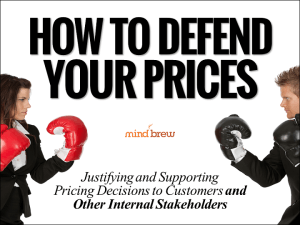It’s a common knee-jerk reaction for salespeople to focus on increasing volume by offering steep discounts on every sale – even if it means sacrificing profitable margins. One way to mitigate the risk of excessive discounting is to establish a pricing system that balances volume incentives with well-defined boundaries that sales staff must operate within.
Ideally, in an effective pricing system, the framework should provide guidance for as many as 80 percent of sales. This guidance should consider a comprehensive range of factors, including the type and size of the customer, the market and the nature of the opportunity. The direction should be clear and unequivocal, providing sales staff with “guardrails” that establish minimum and maximum prices or margins. Sales staff can bounce between these guardrails as appropriate, but they should not be allowed to go above or below the established boundaries.
For the other 20 percent of sales, be prepared to manage the exceptions. For these outliers, the framework allows pricing managers to enter the conversation and work with the sales staff and perhaps even the financial team to develop a strategic price appropriate for a specific situation.
By limiting exceptions to no more than 20 percent of the time, you’ll be able to equalize the competing interests of volume versus margin far better than a one-size-fits-all pricing system. Sales staff will still have the flexibility to manage the majority of sales on their own, allowing them to meet the needs of specific customers as well as their own particular quota goals. But the boundaries you set will prevent those individual goals from overriding your company’s high-level goals.
Every business is different, so the 80/20 framework that’s right for your organization will depend on the type of selling you do. If your business is list-price driven, your pricing system may be able to accommodate higher volume incentives. If you’re in a business where price is highly customized, then your framework may need a more aggressive margin component.
Implementing this system may take some time, as well. Achieving the right balance of guidance and exceptions is a process that often requires fine tuning. It also requires an extensive amount of data and knowledge in order to put together a sustainable system that produces actionable, accurate and real-time insights.
Whatever the framework you decide upon, the 80/20 structure will provide sales staff with the latitude they desire, while protecting the profit margins your organization needs.
For more details on how to develop guard rails for your team and establish an 80/20 structure, check out this article.













